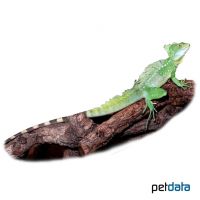Green Basilisk (Basiliscus plumifrons)
| Green Basilisk Basiliscus plumifrons | |
|---|---|
| Name | Green Basilisk |
| Name Lat. | Basiliscus plumifrons |
| Family | Iguanas |
| Family lat. | Iguanidae |
| Order | Scaled Reptiles |
| Order lat. | Squamata |
| Origin | Central America |
| Habitat | Rainforests |
| Diet | Insects, small mammals, fruits |
| Humidity | 70-90 % |
| Behavior | ♂ territorial |
| Keeping | Pair, harem |
| Care Level | Moderate |
| Reproduction | Oviparous |
| Housing | Humid terrarium |
| Life Span | 10 years |
| Protection | No |
| Metric Units | |
| Size | 80 cm |
| Temperature | 25-28 °C |
| Temperature Local | 40-45 °C |
| Housing Size | 120 x 90 x 150 cm |
| US Units | |
| Size | 31" |
| Temperature | 77-82 °F |
| Temperature Local | 104-113 °F |
| Housing Size | 45" x 35" x 60" |
Distribution and habitat
The tree-dwelling, diurnal frontal lobe basilisks live in the dense rainforests of Central America, especially in Honduras, Costa Rica and Panama, where they are always near water. They are good swimmers and divers.
Maintenance
Minimum dimensions for the terrarium, according to the size and number of animals
| 1-2 animals | 5KRL x 3KRL x 4KRL or 4KRL x 3KRL x 5KRL (L x W x H) |
Head-torso length (KRL) is measured on the largest animal. For each additional animal, increase the footprint by 15%. A terrarium of e.g. L 120 x W 90 x H 150 cm is recommended, which should be placed in a quiet and vibration-free place.
They need a spacious terrarium structured with strong climbing branches and horizontal resting places, a substrate of peat-soil mixture, large plants (e.g. Dracaena, Ficus) as well as a large water basin suitable for bathing with a minimum floor area of 2KRL and a water temperature of about 25 °C, ideally with a waterfall. Half of the substrate must be kept moist at all times. Several times a day the inside of the terrarium should be finely sprayed with water (humidity), but a rain or mist system is better
| Temp. day: 25-28 °C | Temp. night: 20-25 °C | Temp. local: up to 45 °C | Humidity: 70-90 % |
Thermostatically controlled floor heating is recommended. The lighting duration must be 10-14 hrs. depending on the season. Special lamps with high UV-A and UV-B content are ideal, because daily UV irradiation is essential.
Diet
The diet consists of live insects, such as crickets, house crickets, earthworms, zophobas and mealybug larvae, snails, small lizards, fish, nestling rats and mice, plus they occasionally require plant foods, such as vegetables and fruits. Alternatively, special ready-made food for insectivorous reptiles can be offered. Wax moths should rarely be fed in very small amounts because of their large fat content. Regular addition of minerals and vitamins (dusting the food) is important. Young animals should be offered food daily, adults 4-5 times a week. Drinking water must always be available
A varied diet promotes health and prevents deficiency symptoms.
Reproduction and breeding
The male has a thickened tail root (hemipenis pockets) and the eponymous frontal lobes on the head and back of the head are more pronounced in the male
Several times a year (3-5 clutches) the female buries her eggs (8-15 pieces) in a suitable place in the soft soil. The incubation period is 60-110 days at a temperature of 28-30 °C. Small insects are suitable as initial food for the young. The life expectancy can be 10 years.
Important
They can run very fast only on the hind legs, even on the water surface. In their native country they are also called "Jesus lizards". Males behave very territorial and are incompatible with each other.
For the resting phase, the lighting time is shortened by 2-3 hours for about two months and the temperature is lowered by 3-4°C. The water basin must be cleaned often, because the droppings are preferentially deposited there
The quality of the food animals can be upgraded by giving fruit and honey water.
The terrarium must have good ventilation without drafts and meet the species specific needs. Measuring devices such as thermometers, hygrometers, etc. are necessary. The lighting has to correspond to the species-specific day-night rhythm and has to be placed in such a way that the animals cannot injure themselves. The terrarium should be locked in such a way that neither unauthorized persons can open it nor the animals can escape. Contamination must be removed regularly.
Further literature can be found in your pet store.
References
Text: petdata; Image: petdata
Source: BMELV (1997): Tierschutzgutachten - Mindestanforderungen an die Haltung von Reptilien; ENGELMANN (2006): Zootierhaltung - Tiere in menschlicher Obhut: Reptilien und Amphibien, Harri Deutsch Verlag
- Gemäß § 21 Abs. 5 Tierschutzgesetz idgF
